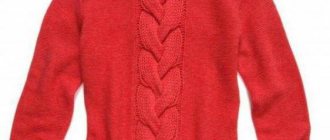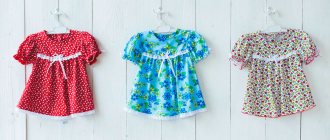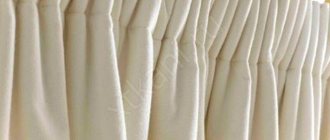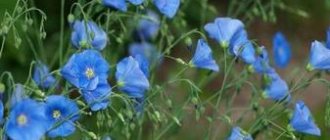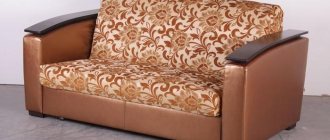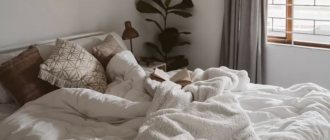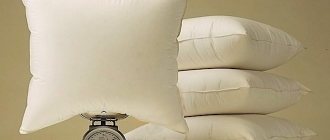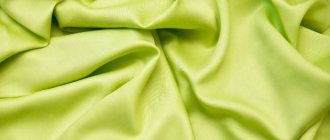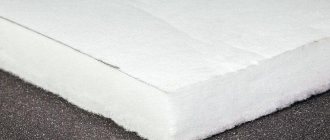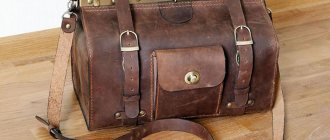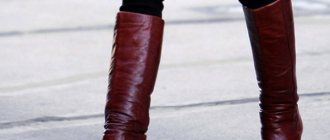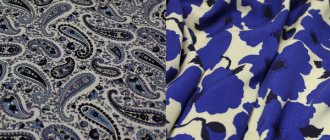26.05.2021
Translated from French, knitwear is a knitted product. The basis of the seamless knitted fabric was yarn and threads through the use of specialized spinning equipment. Knitwear forms the basis of the modern wardrobe for both men, women and children. Knitted clothing is durable, environmentally friendly, and has a breathable texture that allows air to pass through unhindered.
Differences between knitwear and regular fabric
The main difference between knitted fabric and fabric, which is also a textile material, can be determined by considering the structure of the fabric.
The fabric is an interweaving of two systems of threads - warp and weft, longitudinal and transverse, which are intertwined in a certain order, depending on the type of fabric.
Knitwear is a continuous transformation of thread into loops, intertwined in a certain given order.
The conclusion is this: fabric is an interweaving of threads, and knitwear is an interlacing of loops.
What is so good about knitted material and things made from knitwear? What should you know when planning to buy or sew a knitted item? And does this magical material have any drawbacks? It is more convenient to consider the pros and cons in two groups:
- in a sock;
- when sewing.
Assortment of knitwear
3. Sports underwear: briefs, briefs, swim briefs, T-shirts, mesh T-shirts, sports jerseys, bathing suits, swimming trunks, wrestling shorts, vests.
4. Children's underwear: boys' sweatshirts, boys' underpants, outer shirts, sweatshirts made of mesh fabric, pantaloons, pantaloons, bras, shirts, nightshirts, shirts - pantaloons (set), combination - pantaloons or combination - pantaloons-panties (set ), combinations, sports briefs, swimming trunks, T-shirts, mesh T-shirts, sports sweatshirts, swimsuits, wrestling shorts, vests, blouses for toddlers, baby vests, sandboxes, overalls, rompers, envelopes, caps, sets - blouse, sliders and cap , sets - blouse, booties and mittens, sets - blouse, overalls, cap and booties, sets - blouse and sandbox, sets - vest and cap.
Outer Jerseys:
Pullovers (without a collar, a slit or a fastener), men's jackets with long sleeves, women's jackets, sleeveless vests, jumpers (with a slit at the collar, a clasp or without a clasp, with a collar and without a collar), sweaters, leggings, blouses, dresses, skirts, suits (jacket and skirt), jackets, trousers, pajamas, jackets, dressing gowns, ski suits, sets - sweater, scarf and hat, children's suits (a combination of two or three of the items listed above).
Hosiery:
Women's stockings, men's socks, women's socks, sports stockings, leggings, children's stockings, children's socks, half-stockings, knee pads, ankle pads, leggings with traces (tights), underfoot pads.
Gloves:
Gloves made of knitted fabric; knitted gloves; mittens sewn from knitted fabric; knitted mittens.
Scarves, hats, shawls and batting:
Scarves, hats for adults and children, berets, balaclavas, shawls, batting.
Depending on the type of raw material and the nature of the fiber, products are distinguished: pure wool, half-wool, made from artificial and synthetic threads, cotton, mixed and vigon.
In addition, knitted products are also characterized by the thickness (number) of the threads from which the knitwear is made, the number of folds of the threads, twist, etc.
Depending on the structure of the knitwear, products are divided into single woven, double woven, single warp knitted and double warp knitted. Within divisions according to the structure of the product, they are distinguished by weave.
The mentioned characteristics of the products are technical, depending on the type and class of the machine on which the knitwear was produced, and, as a rule, is not attributed to the name of the product.
Products, depending on the basic nature of finishing and dyeing of knitwear, are divided into gray, bleached, plain-dyed, with a structural effect and variegated.
Products may have other characteristic features, which are sometimes indicated in the name of the product, for example, mercerized, printed, etc.
The described classification does not exhaust all the characteristics by which knitted products can be distinguished. However, their names would be very cumbersome if they contained all the listed characteristics; but even with a complete listing of the mentioned features, a sufficiently accurate description of the product will not be obtained. Therefore, practically in industry and trade they use a symbol for each type of product - an article.
The article number of a knitted product is a symbol in the form of a serial number according to the price list attached to the name of the product. For example, a wool blend jacket art. 2247. The definition of the article is based on the following characteristics: type of raw material, yarn number and type of knitting machine. Wool blend jacket art. 2247 differs from other wool blend jackets in that it is made from wool blend yarn T = 33.2 tex-2 (No. 30/2) on a 9-10 grade fang jacquard machine.
The term grade (I and II) is used to indicate the quality of knitted products of a given article in accordance with the grading rules.
The price list for knitted products provides about 1,800 different articles, including articles by type of product: hosiery 430, underwear - 640, outerwear - 550, gloves and other products - about 180.
The knitting industry usually produces at a time no more than half the number of articles included in the price list and selected by trading organizations for a given season. The choice of articles for production at each enterprise is agreed upon with trading organizations every three months. Depending on the time of year, the list of articles changes accordingly.
To fully satisfy consumer requirements, the industry is continuously developing new varieties of knitted products, and the list of articles increases annually by several dozen. The article is assigned to products when prices are approved.
In addition to the article number, knitted products vary in size and must comply with the standard or specifications.
Pros and cons of wearing knitwear
- Knitwear can stretch in all directions. This happens thanks to the loops that form it, which can take any shape.
- Knitted items do not wrinkle, also thanks to the forming loops.
- Knitwear has unique breathability: it warms in cold weather and cools in hot weather. This is due to its structure, similar to a fine mesh.
- Knitted items can be either voluminous or thin and elegant.
- Knitwear does not lose its shape even with prolonged use. This is also a merit of intertwined loops.
- Knitted products do not restrict your movements, which is why they are so loved by everyone.
- The knitwear is pleasant to the touch.
- Due to its good stretchability, knitwear fits the body wonderfully and is convenient to wear under other clothes.
- Knitted fabric does not accumulate static electricity.
- Knitwear is easy to care for, only washing is necessary and ironing is not necessary.
- Knitted products are sold at affordable prices.
Knitted fabrics. Their types and features
Knitted products are very convenient, comfortable and easy to make. The main property of knitted fabrics is elasticity, which provides a better fit compared to other materials. In addition, open cuts usually do not fray and do not require additional processing, so knitwear can be sewn on a regular sewing machine, without using an overlocker.
How to choose knitwear
- Check the fabric for defects - ties, loose loops, wrinkles that will not be smoothed out, fading on the folds of the fabric.
- Pay attention to the composition of the fabric and the percentage of shrinkage that should be indicated on the label. If this information is not available, be sure to check these points with the seller.
- Check the quality of the knitting. This does not require special knowledge. Just look at the canvas, it should be smooth. No distortions, when the canvas visually “mows”, can be corrected.
Composition of knitted fabrics
Knitwear made from natural fibers
It allows air to pass through well, products made from it are comfortable and pleasant to the body. Cotton knitwear is presented in a wide range of stores. It is in great demand for its softness, durability and affordable price. The material is not difficult to sew and is easy to care for. The same cannot be said about silk, viscose, linen and wool knitwear. Each of them requires special attention.
Synthetic knitwear
It is not afraid of machine washing, does not fade or wrinkle. It dries quickly, but products made from it do not allow air to pass through, and the fabric is highly electrified.
Blended knitted fabrics
combine the features of both natural and synthetic fabrics. This knitwear wrinkles less and has greater wear resistance. One big disadvantage is the formation of pellets on the surface of the fabric.
Types of knitted fabrics
Almost any knitwear looks like a knitted fabric.
As a rule, on the front side of the fabric, the loops are front - longitudinal rows, reminiscent of pigtails, and on the back side - purl, transverse rows.
This type of knitwear is also called single knitwear. It stretches well in width and practically does not stretch in length. Double knit or reversible looks the same on both sides. Thick knitted fabrics are most often made in this way. They hold their shape well, and products made from them hide figure imperfections.
Jersey
- a type of single knitwear of different densities. Suitable for almost any product.
Double jersey
or double-sided, double face - most often dense and monochromatic, heavy, with little stretch. It makes good jackets, sheath dresses, tapered skirts, and trousers.
Interlock
- light fabric with “braids” on both the front and back sides. Sportswear, T-shirts, tank tops, pajamas are often made from this type of knitwear.
Sweatshirt
— knitwear is smooth on the front side and brushed on the back. Great for insulated clothing, such as anoraks, sweatshirts, sweatpants.
Sweater knitwear
It is distinguished by a variety of textures: light and smooth, dense, textured knitting, with pile, for example, mohair, or without it. In addition, sweater knitwear is found on sale in the form of finished product parts, in the form of a cuff strip or neck trim. Accordingly, pullovers and loose-fitting dresses are made from such knitwear.
Ribbed knitwear or “noodles”
The canvas has convex stripes of several “braids” on the front and back sides. It stretches well. Turtlenecks, pullovers and tailored dresses are made from it. Used for finishing in the form of cuffs.
Stretch knitwear
made from highly elastic synthetic fibers. It stretches very well and quickly restores its original shape. One example of such knitwear is supplex. Ideal material for swimsuits, sports leggings.
Terry jersey
on the front side it looks like a regular bath towel, and on the back side there are vertical “braids”. Excellent fabric for home wear.
Velours
It has a velvety surface on the outside and vertical “braids” on the inside. Drapes very well.
Stretch corduroy
very similar to knitted velor, but with a glossier pile.
Mesh knitwear
distinguished by a pronounced cellular structure.
Most often, it is used as decorative elements, but entire products are also sewn from it, for example, beach tops and tunics. We have listed the main types of knitwear. But fabric production technologies do not stand still, and improved types of knitted fabrics, with new names and properties, are increasingly appearing on sale.
From our master classes you will learn about some of the secrets of sewing knitwear, as well as how to “tame” this fabric without an overlocker.
Photo: Yulia Dekanova Material prepared by: Yulia Dekanova
